- Privacy Policy

Home » Research Objectives – Types, Examples and Writing Guide

Research Objectives – Types, Examples and Writing Guide
Table of Contents
Research objectives are the specific goals or aims that a researcher intends to achieve through their study. They provide a clear direction for the research, define its scope, and guide the methodology. Well-written research objectives ensure that the study remains focused and aligned with the research problem. This article explores the concept of research objectives, their types, practical examples, and a comprehensive guide to writing them effectively.

Research Objectives
Research objectives are precise statements that describe what the researcher aims to accomplish. They outline the purpose of the study and the specific questions it seeks to answer. Research objectives are essential for providing clarity and structure to the research process.
For example, in a study examining the impact of online learning on student performance, a research objective could be: “To evaluate the effect of online learning platforms on the academic performance of high school students during the COVID-19 pandemic.”
Importance of Research Objectives
- Focus: Help narrow the research scope to specific, achievable goals.
- Guidance: Provide a roadmap for selecting research methods and designing the study.
- Clarity: Ensure that the researcher and audience understand the purpose of the study.
- Evaluation: Serve as benchmarks for assessing whether the study has achieved its goals.
Types of Research Objectives
1. general objectives.
General objectives (also called broad objectives) provide an overview of the research’s primary aim. They describe the main purpose of the study in a concise manner.
- Example: “To explore the relationship between exercise and mental health among young adults.”
2. Specific Objectives
Specific objectives break down the general objective into smaller, more focused goals. They address the research questions or hypotheses and guide data collection and analysis.
- “To assess the frequency of exercise among young adults.”
- “To evaluate the impact of different types of exercise on anxiety levels.”
3. Descriptive Objectives
Descriptive objectives aim to describe characteristics, behaviors, or phenomena without investigating cause-and-effect relationships.
- Example: “To describe the demographics of patients visiting a rural health clinic.”
4. Exploratory Objectives
Exploratory objectives seek to investigate unknown or poorly understood phenomena. They are often used in preliminary or qualitative research.
- Example: “To explore the challenges faced by teachers transitioning to online education.”
5. Explanatory Objectives
Explanatory objectives aim to understand cause-and-effect relationships between variables.
- Example: “To determine how income level influences consumer purchasing behavior.”
6. Evaluative Objectives
Evaluative objectives assess the effectiveness or outcomes of a specific program, intervention, or policy.
- Example: “To evaluate the impact of a workplace wellness program on employee productivity.”
Examples of Research Objectives
1. Title: The Impact of Remote Learning on High School Students’ Academic Performance
Research Objectives:
- To assess the effectiveness of remote learning compared to traditional classroom learning.
- To identify the challenges faced by high school students during remote learning.
- To examine the role of parental support in enhancing students’ performance in a remote learning environment.
- To evaluate the influence of access to technology on students’ academic success during remote education.
2. Title: The Role of Emotional Intelligence in Leadership Success
- To determine the relationship between emotional intelligence and leadership effectiveness.
- To identify key emotional intelligence traits that contribute to successful leadership.
- To explore the impact of emotional intelligence on decision-making in organizational settings.
- To analyze differences in emotional intelligence levels between leaders in various industries.
3. Title: The Effect of Social Media on Consumer Purchasing Decisions
- To analyze the influence of social media advertising on consumer buying behavior.
- To assess the role of peer reviews and recommendations on social media in shaping purchase decisions.
- To evaluate the impact of influencer marketing on brand perception and consumer loyalty.
- To identify differences in purchasing behavior across demographic groups exposed to social media marketing.
4. Title: Analyzing Employee Motivation in Hybrid Work Environments
- To explore the factors affecting employee motivation in hybrid work models.
- To assess the impact of flexible work arrangements on job satisfaction and productivity.
- To determine the role of communication and collaboration tools in maintaining employee engagement.
- To evaluate differences in motivation levels between employees working remotely and in-office.
5. Title: Exploring Sustainable Tourism Practices in Urban Areas
- To identify sustainable practices implemented by urban tourism operators.
- To assess the impact of sustainable tourism practices on local communities and economies.
- To evaluate the awareness and preferences of tourists toward eco-friendly travel options.
- To recommend strategies for promoting sustainable tourism in densely populated urban areas.
How to Write Effective Research Objectives
Step 1: define your research problem.
Begin by identifying the research problem or question. Your objectives should directly address this problem.
- Example Problem: How does social media influence teenagers’ self-esteem?
- Objective: “To analyze the relationship between social media usage and self-esteem among teenagers.”
Step 2: Start with a General Objective
Write a broad statement summarizing the overall aim of your research.
- Example General Objective: “To study the effects of workplace diversity on team performance.”
Step 3: Break Down Into Specific Objectives
Divide the general objective into smaller, specific goals that detail what the research will examine.
- “To identify the impact of gender diversity on team communication.”
- “To evaluate the influence of cultural diversity on innovation.”
Step 4: Use Action Verbs
Write objectives using clear, measurable action verbs such as “analyze,” “evaluate,” “determine,” “assess,” or “explore.” Avoid vague terms like “understand” or “study.”
- Example: Instead of “To study student behavior,” write “To analyze the factors influencing student behavior in classrooms.”
Step 5: Ensure Feasibility
Make sure your objectives are achievable within the scope, timeframe, and resources of your research.
- Example: Instead of “To explore global health outcomes,” narrow the focus to a specific region or population.
Step 6: Align with Research Design
Ensure that your objectives align with your chosen research methodology (qualitative, quantitative, or mixed methods).
- Example: For a quantitative study, an objective might be “To measure the correlation between exercise frequency and stress levels.”
Step 7: Maintain Clarity and Specificity
Write objectives that are clear, concise, and unambiguous to avoid confusion.
Tips for Writing Strong Research Objectives
- Focus on the Research Problem: Ensure each objective directly addresses the central research question.
- Keep Objectives Measurable: Use specific, quantifiable terms to track progress and outcomes.
- Limit the Number of Objectives: Avoid overloading your study with too many goals. Aim for 3–5 specific objectives.
- Write in the Present Tense: Use active voice and present tense for clarity.
- Consult Your Supervisor or Team: Seek feedback to ensure your objectives are relevant and achievable.
Common Mistakes to Avoid
- Weak Objective: “To improve healthcare.”
- Revised Objective: “To evaluate the impact of telemedicine on patient satisfaction in rural areas.”
- Weak Objective: “To understand employee motivation.”
- Revised Objective: “To analyze the factors influencing employee motivation in tech startups.”
- Example: A small-scale study attempting to analyze global trends without adequate resources.
- Overloading with Objectives: Too many objectives can dilute the focus and complicate the study.
Research objectives are essential for guiding a study and ensuring its success. They define the purpose, scope, and direction of the research, making it easier to select methodologies, analyze data, and draw conclusions. By understanding the types of objectives and following a structured writing process, researchers can create clear, specific, and achievable goals that align with their research problems. Whether in education, healthcare, or business, well-written research objectives are key to producing impactful and meaningful results.
- Creswell, J. W. (2018). Research Design: Qualitative, Quantitative, and Mixed Methods Approaches . Sage Publications.
- Babbie, E. (2020). The Practice of Social Research . Cengage Learning.
- Kumar, R. (2019). Research Methodology: A Step-by-Step Guide for Beginners . Sage Publications.
- Punch, K. F. (2016). Developing Effective Research Proposals . Sage Publications.
- Flick, U. (2018). An Introduction to Qualitative Research . Sage Publications.
About the author
Muhammad Hassan
Researcher, Academic Writer, Web developer
You may also like

Thesis Format – Templates and Samples

Figures in Research Paper – Examples and Guide

Dissertation – Format, Example and Template

Research Questions – Types, Examples and Writing...

Thesis Outline – Example, Template and Writing...

Tables in Research Paper – Types, Creating Guide...
21 Research Objectives Examples (Copy and Paste)

Chris Drew (PhD)
Dr. Chris Drew is the founder of the Helpful Professor. He holds a PhD in education and has published over 20 articles in scholarly journals. He is the former editor of the Journal of Learning Development in Higher Education. [Image Descriptor: Photo of Chris]
Learn about our Editorial Process
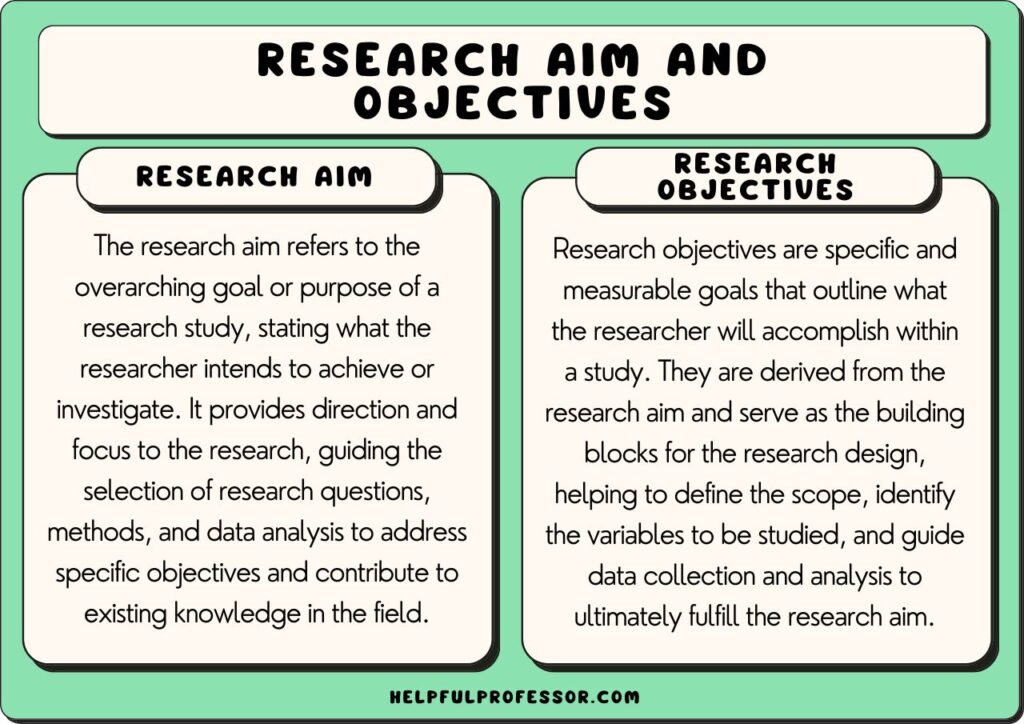
Research objectives refer to the definitive statements made by researchers at the beginning of a research project detailing exactly what a research project aims to achieve.
These objectives are explicit goals clearly and concisely projected by the researcher to present a clear intention or course of action for his or her qualitative or quantitative study.
Research objectives are typically nested under one overarching research aim. The objectives are the steps you’ll need to take in order to achieve the aim (see the examples below, for example, which demonstrate an aim followed by 3 objectives, which is what I recommend to my research students).
Research Objectives vs Research Aims
Research aim and research objectives are fundamental constituents of any study, fitting together like two pieces of the same puzzle.
The ‘research aim’ describes the overarching goal or purpose of the study (Kumar, 2019). This is usually a broad, high-level purpose statement, summing up the central question that the research intends to answer.
Example of an Overarching Research Aim:
“The aim of this study is to explore the impact of climate change on crop productivity.”
Comparatively, ‘research objectives’ are concrete goals that underpin the research aim, providing stepwise actions to achieve the aim.
Objectives break the primary aim into manageable, focused pieces, and are usually characterized as being more specific, measurable, achievable, relevant, and time-bound (SMART).
Examples of Specific Research Objectives:
1. “To examine the effects of rising temperatures on the yield of rice crops during the upcoming growth season.” 2. “To assess changes in rainfall patterns in major agricultural regions over the first decade of the twenty-first century (2000-2010).” 3. “To analyze the impact of changing weather patterns on crop diseases within the same timeframe.”
The distinction between these two terms, though subtle, is significant for successfully conducting a study. The research aim provides the study with direction, while the research objectives set the path to achieving this aim, thereby ensuring the study’s efficiency and effectiveness.
How to Write Research Objectives
I usually recommend to my students that they use the SMART framework to create their research objectives.
SMART is an acronym standing for Specific, Measurable, Achievable, Relevant, and Time-bound. It provides a clear method of defining solid research objectives and helps students know where to start in writing their objectives (Locke & Latham, 2013).
Each element of this acronym adds a distinct dimension to the framework, aiding in the creation of comprehensive, well-delineated objectives.
Here is each step:
- Specific : We need to avoid ambiguity in our objectives. They need to be clear and precise (Doran, 1981). For instance, rather than stating the objective as “to study the effects of social media,” a more focused detail would be “to examine the effects of social media use (Facebook, Instagram, and Twitter) on the academic performance of college students.”
- Measurable: The measurable attribute provides a clear criterion to determine if the objective has been met (Locke & Latham, 2013). A quantifiable element, such as a percentage or a number, adds a measurable quality. For example, “to increase response rate to the annual customer survey by 10%,” makes it easier to ascertain achievement.
- Achievable: The achievable aspect encourages researchers to craft realistic objectives, resembling a self-check mechanism to ensure the objectives align with the scope and resources at disposal (Doran, 1981). For example, “to interview 25 participants selected randomly from a population of 100” is an attainable objective as long as the researcher has access to these participants.
- Relevance : Relevance, the fourth element, compels the researcher to tailor the objectives in alignment with overarching goals of the study (Locke & Latham, 2013). This is extremely important – each objective must help you meet your overall one-sentence ‘aim’ in your study.
- Time-Bound: Lastly, the time-bound element fosters a sense of urgency and prioritization, preventing procrastination and enhancing productivity (Doran, 1981). “To analyze the effect of laptop use in lectures on student engagement over the course of two semesters this year” expresses a clear deadline, thus serving as a motivator for timely completion.
You’re not expected to fit every single element of the SMART framework in one objective, but across your objectives, try to touch on each of the five components.
Research Objectives Examples
1. Field: Psychology
Aim: To explore the impact of sleep deprivation on cognitive performance in college students.
- Objective 1: To compare cognitive test scores of students with less than six hours of sleep and those with 8 or more hours of sleep.
- Objective 2: To investigate the relationship between class grades and reported sleep duration.
- Objective 3: To survey student perceptions and experiences on how sleep deprivation affects their cognitive capabilities.
2. Field: Environmental Science
Aim: To understand the effects of urban green spaces on human well-being in a metropolitan city.
- Objective 1: To assess the physical and mental health benefits of regular exposure to urban green spaces.
- Objective 2: To evaluate the social impacts of urban green spaces on community interactions.
- Objective 3: To examine patterns of use for different types of urban green spaces.
3. Field: Technology
Aim: To investigate the influence of using social media on productivity in the workplace.
- Objective 1: To measure the amount of time spent on social media during work hours.
- Objective 2: To evaluate the perceived impact of social media use on task completion and work efficiency.
- Objective 3: To explore whether company policies on social media usage correlate with different patterns of productivity.
4. Field: Education
Aim: To examine the effectiveness of online vs traditional face-to-face learning on student engagement and achievement.
- Objective 1: To compare student grades between the groups exposed to online and traditional face-to-face learning.
- Objective 2: To assess student engagement levels in both learning environments.
- Objective 3: To collate student perceptions and preferences regarding both learning methods.
5. Field: Health
Aim: To determine the impact of a Mediterranean diet on cardiac health among adults over 50.
- Objective 1: To assess changes in cardiovascular health metrics after following a Mediterranean diet for six months.
- Objective 2: To compare these health metrics with a similar group who follow their regular diet.
- Objective 3: To document participants’ experiences and adherence to the Mediterranean diet.
6. Field: Environmental Science
Aim: To analyze the impact of urban farming on community sustainability.
- Objective 1: To document the types and quantity of food produced through urban farming initiatives.
- Objective 2: To assess the effect of urban farming on local communities’ access to fresh produce.
- Objective 3: To examine the social dynamics and cooperative relationships in the creating and maintaining of urban farms.
7. Field: Sociology
Aim: To investigate the influence of home offices on work-life balance during remote work.
- Objective 1: To survey remote workers on their perceptions of work-life balance since setting up home offices.
- Objective 2: To conduct an observational study of daily work routines and family interactions in a home office setting.
- Objective 3: To assess the correlation, if any, between physical boundaries of workspaces and mental boundaries for work in the home setting.
8. Field: Economics
Aim: To evaluate the effects of minimum wage increases on small businesses.
- Objective 1: To analyze cost structures, pricing changes, and profitability of small businesses before and after minimum wage increases.
- Objective 2: To survey small business owners on the strategies they employ to navigate minimum wage increases.
- Objective 3: To examine employment trends in small businesses in response to wage increase legislation.
9. Field: Education
Aim: To explore the role of extracurricular activities in promoting soft skills among high school students.
- Objective 1: To assess the variety of soft skills developed through different types of extracurricular activities.
- Objective 2: To compare self-reported soft skills between students who participate in extracurricular activities and those who do not.
- Objective 3: To investigate the teachers’ perspectives on the contribution of extracurricular activities to students’ skill development.
10. Field: Technology
Aim: To assess the impact of virtual reality (VR) technology on the tourism industry.
- Objective 1: To document the types and popularity of VR experiences available in the tourism market.
- Objective 2: To survey tourists on their interest levels and satisfaction rates with VR tourism experiences.
- Objective 3: To determine whether VR tourism experiences correlate with increased interest in real-life travel to the simulated destinations.
11. Field: Biochemistry
Aim: To examine the role of antioxidants in preventing cellular damage.
- Objective 1: To identify the types and quantities of antioxidants in common fruits and vegetables.
- Objective 2: To determine the effects of various antioxidants on free radical neutralization in controlled lab tests.
- Objective 3: To investigate potential beneficial impacts of antioxidant-rich diets on long-term cellular health.
12. Field: Linguistics
Aim: To determine the influence of early exposure to multiple languages on cognitive development in children.
- Objective 1: To assess cognitive development milestones in monolingual and multilingual children.
- Objective 2: To document the number and intensity of language exposures for each group in the study.
- Objective 3: To investigate the specific cognitive advantages, if any, enjoyed by multilingual children.
13. Field: Art History
Aim: To explore the impact of the Renaissance period on modern-day art trends.
- Objective 1: To identify key characteristics and styles of Renaissance art.
- Objective 2: To analyze modern art pieces for the influence of the Renaissance style.
- Objective 3: To survey modern-day artists for their inspirations and the influence of historical art movements on their work.
14. Field: Cybersecurity
Aim: To assess the effectiveness of two-factor authentication (2FA) in preventing unauthorized system access.
- Objective 1: To measure the frequency of unauthorized access attempts before and after the introduction of 2FA.
- Objective 2: To survey users about their experiences and challenges with 2FA implementation.
- Objective 3: To evaluate the efficacy of different types of 2FA (SMS-based, authenticator apps, biometrics, etc.).
15. Field: Cultural Studies
Aim: To analyze the role of music in cultural identity formation among ethnic minorities.
- Objective 1: To document the types and frequency of traditional music practices within selected ethnic minority communities.
- Objective 2: To survey community members on the role of music in their personal and communal identity.
- Objective 3: To explore the resilience and transmission of traditional music practices in contemporary society.
16. Field: Astronomy
Aim: To explore the impact of solar activity on satellite communication.
- Objective 1: To categorize different types of solar activities and their frequencies of occurrence.
- Objective 2: To ascertain how variations in solar activity may influence satellite communication.
- Objective 3: To investigate preventative and damage-control measures currently in place during periods of high solar activity.
17. Field: Literature
Aim: To examine narrative techniques in contemporary graphic novels.
- Objective 1: To identify a range of narrative techniques employed in this genre.
- Objective 2: To analyze the ways in which these narrative techniques engage readers and affect story interpretation.
- Objective 3: To compare narrative techniques in graphic novels to those found in traditional printed novels.
18. Field: Renewable Energy
Aim: To investigate the feasibility of solar energy as a primary renewable resource within urban areas.
- Objective 1: To quantify the average sunlight hours across urban areas in different climatic zones.
- Objective 2: To calculate the potential solar energy that could be harnessed within these areas.
- Objective 3: To identify barriers or challenges to widespread solar energy implementation in urban settings and potential solutions.
19. Field: Sports Science
Aim: To evaluate the role of pre-game rituals in athlete performance.
- Objective 1: To identify the variety and frequency of pre-game rituals among professional athletes in several sports.
- Objective 2: To measure the impact of pre-game rituals on individual athletes’ performance metrics.
- Objective 3: To examine the psychological mechanisms that might explain the effects (if any) of pre-game ritual on performance.
20. Field: Ecology
Aim: To investigate the effects of urban noise pollution on bird populations.
- Objective 1: To record and quantify urban noise levels in various bird habitats.
- Objective 2: To measure bird population densities in relation to noise levels.
- Objective 3: To determine any changes in bird behavior or vocalization linked to noise levels.
21. Field: Food Science
Aim: To examine the influence of cooking methods on the nutritional value of vegetables.
- Objective 1: To identify the nutrient content of various vegetables both raw and after different cooking processes.
- Objective 2: To compare the effect of various cooking methods on the nutrient retention of these vegetables.
- Objective 3: To propose cooking strategies that optimize nutrient retention.
The Importance of Research Objectives
The importance of research objectives cannot be overstated. In essence, these guideposts articulate what the researcher aims to discover, understand, or examine (Kothari, 2014).
When drafting research objectives, it’s essential to make them simple and comprehensible, specific to the point of being quantifiable where possible, achievable in a practical sense, relevant to the chosen research question, and time-constrained to ensure efficient progress (Kumar, 2019).
Remember that a good research objective is integral to the success of your project, offering a clear path forward for setting out a research design , and serving as the bedrock of your study plan. Each objective must distinctly address a different dimension of your research question or problem (Kothari, 2014). Always bear in mind that the ultimate purpose of your research objectives is to succinctly encapsulate your aims in the clearest way possible, facilitating a coherent, comprehensive and rational approach to your planned study, and furnishing a scientific roadmap for your journey into the depths of knowledge and research (Kumar, 2019).
Kothari, C.R (2014). Research Methodology: Methods and Techniques . New Delhi: New Age International.
Kumar, R. (2019). Research Methodology: A Step-by-Step Guide for Beginners .New York: SAGE Publications.
Doran, G. T. (1981). There’s a S.M.A.R.T. way to write management’s goals and objectives. Management review, 70 (11), 35-36.
Locke, E. A., & Latham, G. P. (2013). New Developments in Goal Setting and Task Performance . New York: Routledge.

- Chris Drew (PhD) https://helpfulprofessor.com/author/chris-drew-phd/ Free Social Skills Worksheets
- Chris Drew (PhD) https://helpfulprofessor.com/author/chris-drew-phd/ 10 Reasons you’re Perpetually Single
- Chris Drew (PhD) https://helpfulprofessor.com/author/chris-drew-phd/ 20 Montessori Toddler Bedrooms (Design Inspiration)
- Chris Drew (PhD) https://helpfulprofessor.com/author/chris-drew-phd/ 21 Montessori Homeschool Setups
Leave a Comment Cancel Reply
Your email address will not be published. Required fields are marked *
Educational resources and simple solutions for your research journey
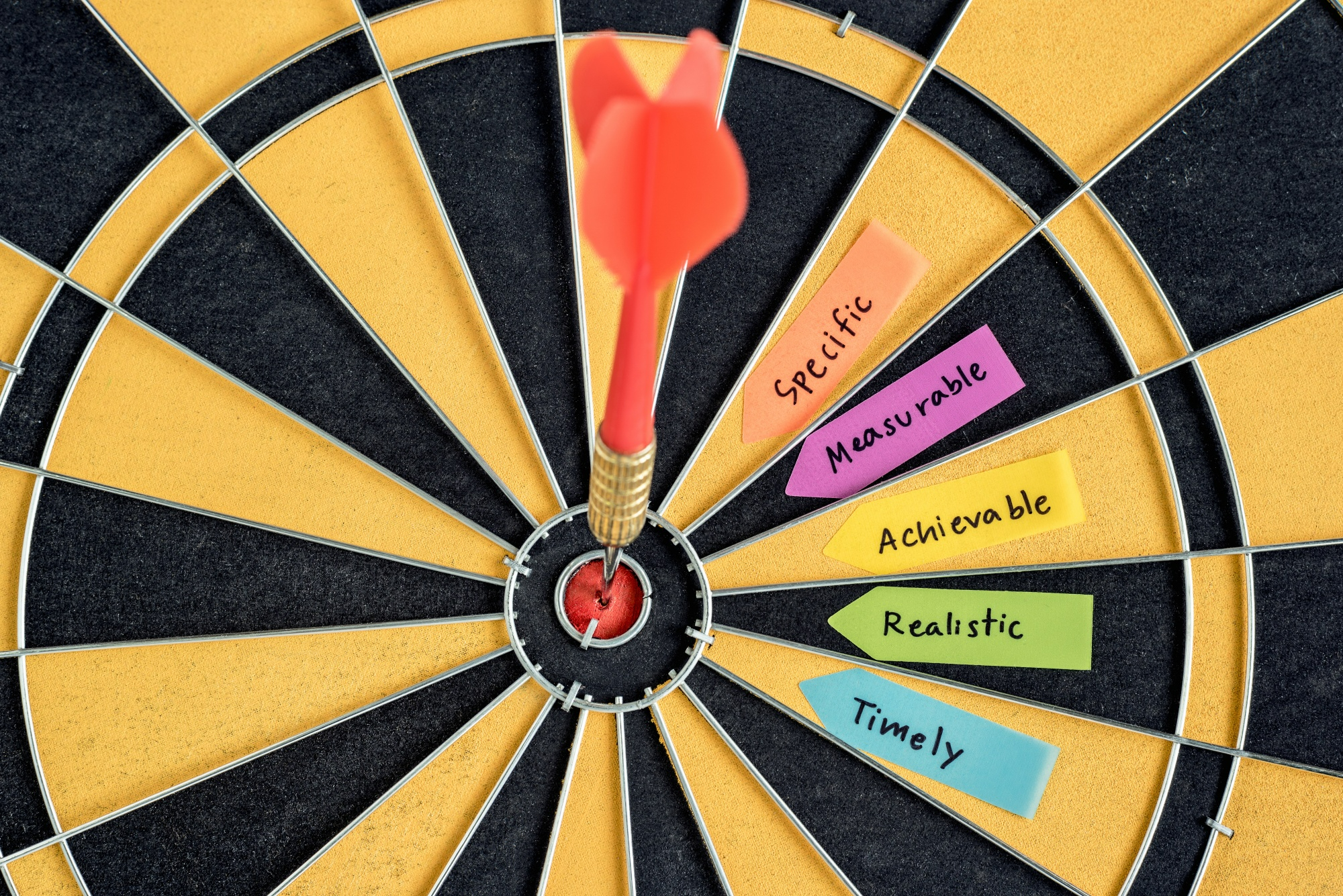
What Are Research Objectives and How to Write Them (with Examples)

Table of Contents
Introduction
Research is at the center of everything researchers do, and setting clear, well-defined research objectives plays a pivotal role in guiding scholars toward their desired outcomes. Research papers are essential instruments for researchers to effectively communicate their work. Among the many sections that constitute a research paper, the introduction plays a key role in providing a background and setting the context. 1 Research objectives, which define the aims of the study, are usually stated in the introduction. Every study has a research question that the authors are trying to answer, and the objective is an active statement about how the study will answer this research question. These objectives help guide the development and design of the study and steer the research in the appropriate direction; if this is not clearly defined, a project can fail!
Research studies have a research question, research hypothesis, and one or more research objectives. A research question is what a study aims to answer, and a research hypothesis is a predictive statement about the relationship between two or more variables, which the study sets out to prove or disprove. Objectives are specific, measurable goals that the study aims to achieve. The difference between these three is illustrated by the following example:
- Research question : How does low-intensity pulsed ultrasound (LIPUS) compare with a placebo device in managing the symptoms of skeletally mature patients with patellar tendinopathy?
- Research hypothesis : Pain levels are reduced in patients who receive daily active-LIPUS (treatment) for 12 weeks compared with individuals who receive inactive-LIPUS (placebo).
- Research objective : To investigate the clinical efficacy of LIPUS in the management of patellar tendinopathy symptoms.
This article discusses the importance of clear, well-thought out objectives and suggests methods to write them clearly.
What is the introduction in research papers?
Research objectives are usually included in the introduction section. This section is the first that the readers will read so it is essential that it conveys the subject matter appropriately and is well written to create a good first impression. A good introduction sets the tone of the paper and clearly outlines the contents so that the readers get a quick snapshot of what to expect.
A good introduction should aim to: 2,3
- Indicate the main subject area, its importance, and cite previous literature on the subject
- Define the gap(s) in existing research, ask a research question, and state the objectives
- Announce the present research and outline its novelty and significance
- Avoid repeating the Abstract, providing unnecessary information, and claiming novelty without accurate supporting information.
Why are research objectives important?
Objectives can help you stay focused and steer your research in the required direction. They help define and limit the scope of your research, which is important to efficiently manage your resources and time. The objectives help to create and maintain the overall structure, and specify two main things—the variables and the methods of quantifying the variables.
A good research objective:
- defines the scope of the study
- gives direction to the research
- helps maintain focus and avoid diversions from the topic
- minimizes wastage of resources like time, money, and energy
Types of research objectives
Research objectives can be broadly classified into general and specific objectives . 4 General objectives state what the research expects to achieve overall while specific objectives break this down into smaller, logically connected parts, each of which addresses various parts of the research problem. General objectives are the main goals of the study and are usually fewer in number while specific objectives are more in number because they address several aspects of the research problem.
Example (general objective): To investigate the factors influencing the financial performance of firms listed in the New York Stock Exchange market.
Example (specific objective): To assess the influence of firm size on the financial performance of firms listed in the New York Stock Exchange market.
In addition to this broad classification, research objectives can be grouped into several categories depending on the research problem, as given in Table 1.
Table 1: Types of research objectives
Characteristics of research objectives
Research objectives must start with the word “To” because this helps readers identify the objective in the absence of headings and appropriate sectioning in research papers. 5,6
- A good objective is SMART (mostly applicable to specific objectives):
- Specific—clear about the what, why, when, and how
- Measurable—identifies the main variables of the study and quantifies the targets
- Achievable—attainable using the available time and resources
- Realistic—accurately addresses the scope of the problem
- Time-bound—identifies the time in which each step will be completed
- Research objectives clarify the purpose of research.
- They help understand the relationship and dissimilarities between variables.
- They provide a direction that helps the research to reach a definite conclusion.
How to write research objectives?
Research objectives can be written using the following steps: 7
- State your main research question clearly and concisely.
- Describe the ultimate goal of your study, which is similar to the research question but states the intended outcomes more definitively.
- Divide this main goal into subcategories to develop your objectives.
- Limit the number of objectives (1-2 general; 3-4 specific)
- Assess each objective using the SMART
- Start each objective with an action verb like assess, compare, determine, evaluate, etc., which makes the research appear more actionable.
- Use specific language without making the sentence data heavy.
- The most common section to add the objectives is the introduction and after the problem statement.
- Add the objectives to the abstract (if there is one).
- State the general objective first, followed by the specific objectives.
Formulating research objectives
Formulating research objectives has the following five steps, which could help researchers develop a clear objective: 8
- Identify the research problem.
- Review past studies on subjects similar to your problem statement, that is, studies that use similar methods, variables, etc.
- Identify the research gaps the current study should cover based on your literature review. These gaps could be theoretical, methodological, or conceptual.
- Define the research question(s) based on the gaps identified.
- Revise/relate the research problem based on the defined research question and the gaps identified. This is to confirm that there is an actual need for a study on the subject based on the gaps in literature.
- Identify and write the general and specific objectives.
- Incorporate the objectives into the study.
Advantages of research objectives
Adding clear research objectives has the following advantages: 4,8
- Maintains the focus and direction of the research
- Optimizes allocation of resources with minimal wastage
- Acts as a foundation for defining appropriate research questions and hypotheses
- Provides measurable outcomes that can help evaluate the success of the research
- Determines the feasibility of the research by helping to assess the availability of required resources
- Ensures relevance of the study to the subject and its contribution to existing literature
Disadvantages of research objectives
Research objectives also have few disadvantages, as listed below: 8
- Absence of clearly defined objectives can lead to ambiguity in the research process
- Unintentional bias could affect the validity and accuracy of the research findings
Key takeaways
- Research objectives are concise statements that describe what the research is aiming to achieve.
- They define the scope and direction of the research and maintain focus.
- The objectives should be SMART—specific, measurable, achievable, realistic, and time-bound.
- Clear research objectives help avoid collection of data or resources not required for the study.
- Well-formulated specific objectives help develop the overall research methodology, including data collection, analysis, interpretation, and utilization.
- Research objectives should cover all aspects of the problem statement in a coherent way.
- They should be clearly stated using action verbs.
Frequently asked questions on research objectives
Q: what’s the difference between research objectives and aims 9.
A: Research aims are statements that reflect the broad goal(s) of the study and outline the general direction of the research. They are not specific but clearly define the focus of the study.
Example: This research aims to explore employee experiences of digital transformation in retail HR.
Research objectives focus on the action to be taken to achieve the aims. They make the aims more practical and should be specific and actionable.
Example: To observe the retail HR employees throughout the digital transformation.
Q: What are the examples of research objectives, both general and specific?
A: Here are a few examples of research objectives:
- To identify the antiviral chemical constituents in Mumbukura gitoniensis (general)
- To carry out solvent extraction of dried flowers of Mumbukura gitoniensis and isolate the constituents. (specific)
- To determine the antiviral activity of each of the isolated compounds. (specific)
- To examine the extent, range, and method of coral reef rehabilitation projects in five shallow reef areas adjacent to popular tourist destinations in the Philippines.
- To investigate species richness of mammal communities in five protected areas over the past 20 years.
- To evaluate the potential application of AI techniques for estimating best-corrected visual acuity from fundus photographs with and without ancillary information.
- To investigate whether sport influences psychological parameters in the personality of asthmatic children.
Q: How do I develop research objectives?
A: Developing research objectives begins with defining the problem statement clearly, as illustrated by Figure 1. Objectives specify how the research question will be answered and they determine what is to be measured to test the hypothesis.
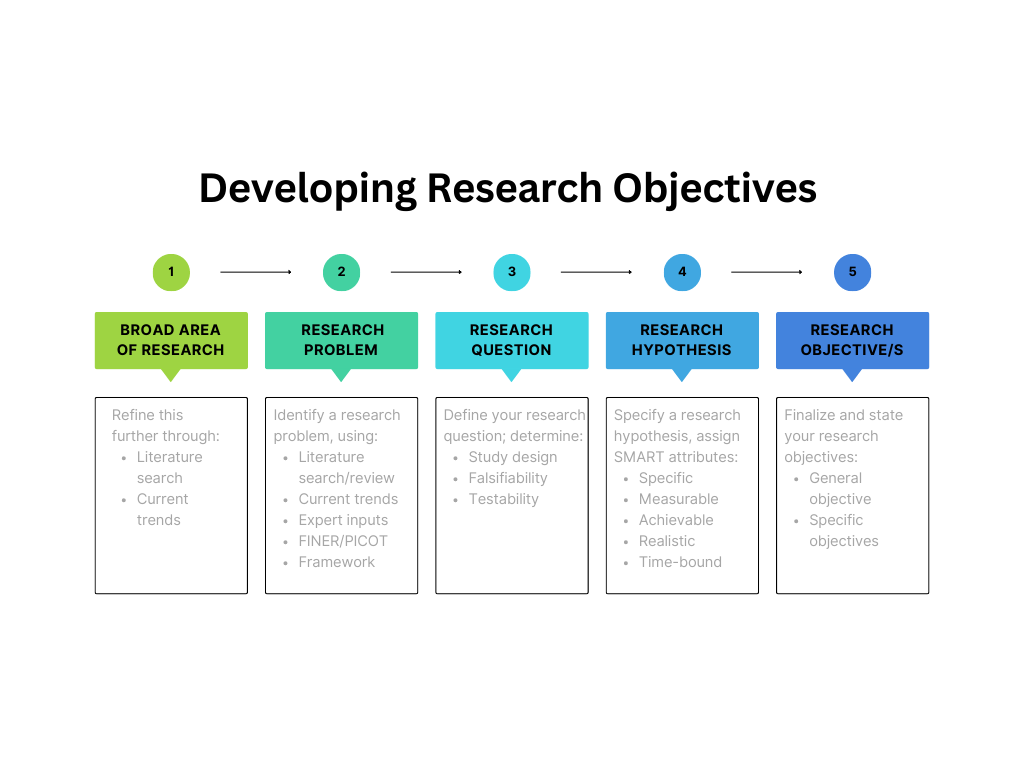
Q: Are research objectives measurable?
A: The word “measurable” implies that something is quantifiable. In terms of research objectives, this means that the source and method of collecting data are identified and that all these aspects are feasible for the research. Some metrics can be created to measure your progress toward achieving your objectives.
Q: Can research objectives change during the study?
A: Revising research objectives during the study is acceptable in situations when the selected methodology is not progressing toward achieving the objective, or if there are challenges pertaining to resources, etc. One thing to keep in mind is the time and resources you would have to complete your research after revising the objectives. Thus, as long as your problem statement and hypotheses are unchanged, minor revisions to the research objectives are acceptable.
Q: What is the difference between research questions and research objectives? 10
Q: are research objectives the same as hypotheses.
A: No, hypotheses are predictive theories that are expressed in general terms. Research objectives, which are more specific, are developed from hypotheses and aim to test them. A hypothesis can be tested using several methods and each method will have different objectives because the methodology to be used could be different. A hypothesis is developed based on observation and reasoning; it is a calculated prediction about why a particular phenomenon is occurring. To test this prediction, different research objectives are formulated. Here’s a simple example of both a research hypothesis and research objective.
Research hypothesis : Employees who arrive at work earlier are more productive.
Research objective : To assess whether employees who arrive at work earlier are more productive.
To summarize, research objectives are an important part of research studies and should be written clearly to effectively communicate your research. We hope this article has given you a brief insight into the importance of using clearly defined research objectives and how to formulate them.
- Farrugia P, Petrisor BA, Farrokhyar F, Bhandari M. Practical tips for surgical research: Research questions, hypotheses and objectives. Can J Surg. 2010 Aug;53(4):278-81.
- Abbadia J. How to write an introduction for a research paper. Mind the Graph website. Accessed June 14, 2023. https://mindthegraph.com/blog/how-to-write-an-introduction-for-a-research-paper/
- Writing a scientific paper: Introduction. UCI libraries website. Accessed June 15, 2023. https://guides.lib.uci.edu/c.php?g=334338&p=2249903
- Research objectives—Types, examples and writing guide. Researchmethod.net website. Accessed June 17, 2023. https://researchmethod.net/research-objectives/#:~:text=They%20provide%20a%20clear%20direction,track%20and%20achieve%20their%20goals .
- Bartle P. SMART Characteristics of good objectives. Community empowerment collective website. Accessed June 16, 2023. https://cec.vcn.bc.ca/cmp/modules/pd-smar.htm
- Research objectives. Studyprobe website. Accessed June 18, 2023. https://www.studyprobe.in/2022/08/research-objectives.html
- Corredor F. How to write objectives in a research paper. wikiHow website. Accessed June 18, 2023. https://www.wikihow.com/Write-Objectives-in-a-Research-Proposal
- Research objectives: Definition, types, characteristics, advantages. AccountingNest website. Accessed June 15, 2023. https://www.accountingnest.com/articles/research/research-objectives
- Phair D., Shaeffer A. Research aims, objectives & questions. GradCoach website. Accessed June 20, 2023. https://gradcoach.com/research-aims-objectives-questions/
- Understanding the difference between research questions and objectives. Accessed June 21, 2023. https://board.researchersjob.com/blog/research-questions-and-objectives
R Discovery is a literature search and research reading platform that accelerates your research discovery journey by keeping you updated on the latest, most relevant scholarly content. With 250M+ research articles sourced from trusted aggregators like CrossRef, Unpaywall, PubMed, PubMed Central, Open Alex and top publishing houses like Springer Nature, JAMA, IOP, Taylor & Francis, NEJM, BMJ, Karger, SAGE, Emerald Publishing and more, R Discovery puts a world of research at your fingertips.
Try R Discovery Prime FREE for 1 week or upgrade at just US$72 a year to access premium features that let you listen to research on the go, read in your language, collaborate with peers, auto sync with reference managers, and much more. Choose a simpler, smarter way to find and read research – Download the app and start your free 7-day trial today !
Related Posts

4 Types of Essays in Academic Writing

What is an SCI-indexed Journal?
What is a Research Objective? Definition, Types, Examples and Best Practices
By Nick Jain
Published on: September 8, 2023
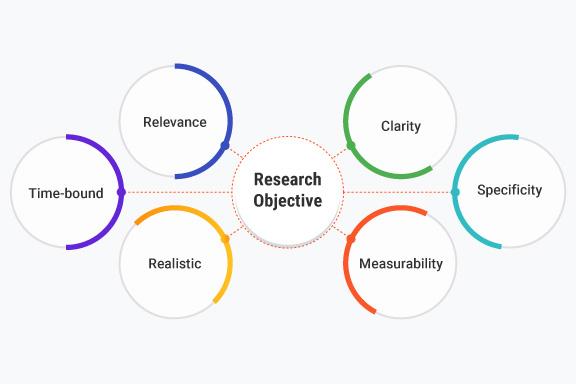
Table of Contents
What is a Research Objective?
Types of research objectives, top 6 examples of research objectives, research objectives best practices.
A research objective is defined as a clear and concise statement of the specific goals and aims of a research study. It outlines what the researcher intends to accomplish and what they hope to learn or discover through their research. Research objectives are crucial for guiding the research process and ensuring that the study stays focused and on track.
Key characteristics of research objectives include:
- Clarity: Research objectives should be clearly defined and easy to understand. One should ensure there is no space for ambiguity or misinterpretation.
- Specificity: Objectives should be specific and narrowly focused on the aspects of the research topic that the study intends to investigate. They should answer the question of “what” or “which” rather than “how” or “why.”
- Measurability: Research objectives should be formulated in a way that allows for measurement and evaluation. This means that there should be a way to determine whether the objectives have been achieved or not.
- Relevance: Objectives should be relevant to the research topic and align with the overall research question or hypothesis. They should address important aspects of the subject matter.
- Realistic: Objectives should be attainable within the constraints of the study, including time, resources, and feasibility.
- Time-bound: Research objectives may have associated timelines or deadlines to indicate when the research aims should be accomplished.
Research objectives help researchers stay focused on the purpose of their study and guide the development of research methods , data collection, and analysis. They also serve as a basis for evaluating the success of the research once it’s completed. In the context of a research project, research objectives typically follow the formulation of a research question or hypothesis and serve as a roadmap for conducting the study.
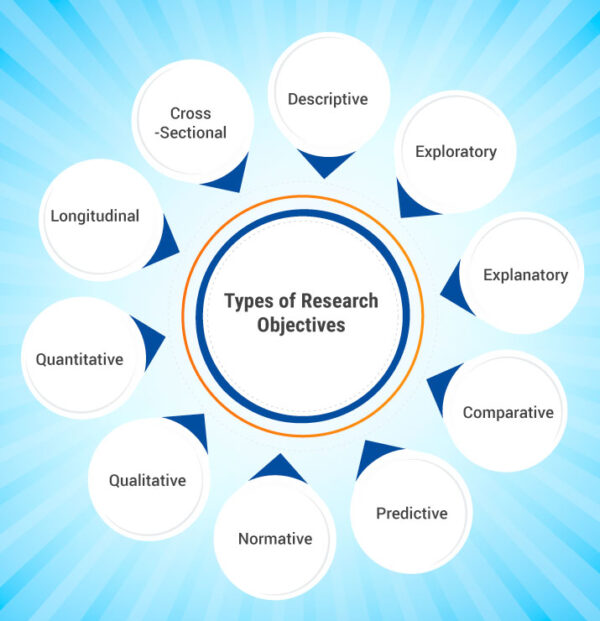
Research objectives can be categorized into different types based on their focus and purpose within a research study. Here are some common types of research objectives:
1. Descriptive Objectives
These objectives aim to provide a detailed and accurate description of a phenomenon, event, or subject. They focus on answering questions about what, who, where, and when.
Example: “To delineate the demographic attributes of the study’s participants.”
2. Exploratory Objectives
Exploratory objectives are used when researchers seek to gain a better understanding of a topic, especially when there is limited existing knowledge. They often involve preliminary investigations.
Example: “To investigate the possible determinants impacting consumer inclinations towards sustainable products.”
3. Explanatory Objectives
Explanatory objectives are designed to identify the relationships between variables and explain the causes or reasons behind certain phenomena.
Example: “To examine the causal relationship between smoking habits and the development of lung cancer.”
4. Comparative Objectives
These objectives involve comparing two or more variables, groups, or situations to identify similarities, differences, patterns, or trends.
Example: “To compare the performance of two different marketing strategies in terms of their impact on sales.”
5. Predictive Objectives
Predictive objectives aim to forecast or predict future outcomes or trends based on existing data or patterns.
Example: “To forecast customer attrition rates within an online subscription service by utilizing historical usage patterns and satisfaction data.”
6. Normative Objectives
Normative objectives involve establishing standards, guidelines, or recommendations for a specific area of study.
Example: “To develop industry-specific ethical guidelines for the responsible use of artificial intelligence.”
7. Qualitative Objectives
Qualitative objectives are used in qualitative research to explore and understand experiences, perceptions, and behaviors in-depth.
Example: “To reveal the latent motivations and emotions of participants within a qualitative interview investigation.”
8. Quantitative Objectives
Quantitative objectives involve the collection and analysis of numerical data to measure and quantify specific phenomena.
Example: “To ascertain the relationship between income levels and the availability of educational resources among a selected group of households.”
9. Longitudinal Objectives
Longitudinal objectives involve studying the same subjects or entities over an extended period to track changes or developments.
Example: “To assess the cognitive development of children from kindergarten through high school graduation.”
10. Cross-Sectional Objectives
Cross-sectional objectives involve the study of a sample at a single point in time to gather data about a population’s characteristics or attitudes.
Example: “To assess the present employment situation and job satisfaction levels among healthcare sector employees.”
The choice of research objective type depends on the nature of the research , the research questions or hypotheses, and the overall goals of the study. Researchers often use a combination of these types to address different aspects of their research inquiries.
Learn more: What is Research Design?
Research objectives can vary widely depending on the field of study and the specific research topic. However, I can provide you with some examples of research objectives in different domains to illustrate their diversity:
1. Healthcare Research
- To investigate the relationship between regular physical activity and the incidence of cardiovascular diseases in adults aged 40-60.
- To assess the effectiveness of a new drug in reducing symptoms of a specific medical condition over a six-month period.
- To identify the factors influencing healthcare-seeking behavior among a specific demographic group.
2. Educational Research
- To examine the impact of technology integration in the classroom on students’ academic performance in mathematics.
- To determine the effectiveness of a new teaching method for improving reading comprehension in elementary school children.
- To explore the factors that contribute to student dropout rates in a particular educational institution.
3. Environmental Science Research
- To analyze the effects of climate change on the migration patterns of a specific bird species in a particular region.
- To investigate the long-term impact of deforestation on local biodiversity in a tropical rainforest.
- To assess the effectiveness of a conservation program in preserving a critically endangered species.
4. Business and Marketing Research
- To evaluate consumer preferences for eco-friendly packaging materials in the cosmetics industry.
- To analyze the market potential for a new product in a specific geographical area.
- To identify the key factors influencing customer loyalty in the fast-food restaurant industry.
5. Social Science Research
- To examine the relationship between socioeconomic status and access to quality healthcare in urban areas.
- To investigate the influence of adolescents’ use of social media on their mental well-being.
- To investigate the factors contributing to workplace diversity and inclusion in a multinational corporation.
6. Psychological Research
- To investigate the effects of mindfulness meditation on reducing symptoms of anxiety in adults.
- To explore the relationship between early childhood experiences and attachment styles in adulthood.
- To analyze the factors influencing decision-making in individuals with specific personality traits.
These examples cover a range of research objectives across different disciplines. Keep in mind that research objectives should be tailored to the specific research question or hypothesis and should be formulated to guide the research process effectively.
Learn more: What is Voice of Customer Research?

Creating effective research objectives is essential for conducting a successful research study. Here are some best practices to keep in mind when formulating research objectives:
- Be Specific and Clear: Research objectives should be precise and unambiguous. They should clearly state what the study aims to achieve, leaving no room for misinterpretation.
- Align with Research Questions or Hypotheses: Ensure that your research objectives directly align with the broader research questions or hypotheses that guide your study. They should help you address those overarching inquiries.
- Use Action Verbs: Start your research objectives with action verbs that describe what you intend to do. Common action verbs include “to investigate,” “to analyze,” “to examine,” “to compare,” “to determine,” etc.
- Focus on Measurable Outcomes: Make sure your research objectives are formulated in a way that allows for measurement and evaluation. There should be a way to determine whether the objectives have been achieved or not.
- Be Realistic and Feasible: Set research objectives that are attainable within the constraints of your study, including available time, budget, and resources. Unrealistic objectives can lead to frustration and failure.
- Consider the Scope of the Study: Keep the scope of your research in mind when defining objectives. Ensure that your objectives are neither too broad nor too narrow. They should be manageable within the context of your study.
- Prioritize Objectives: If you have multiple research objectives, consider prioritizing them. Identify which objectives are most crucial to the success of your study and allocate resources accordingly.
- Ensure Relevance: Objectives should be directly relevant to the research topic and the overall purpose of the study. Avoid including objectives that do not contribute to answering your research questions or testing your hypotheses.
- Consider the Target Audience: Think about who will be reading your research objectives. They should be understandable to both experts in your field and non-expert stakeholders.
- Review and Refine: It’s a good practice to review and refine your research objectives after initial formulation. Seek feedback from peers, advisors, or mentors to ensure they are well-constructed and aligned with your study’s goals.
- Specific: Clarify the specific goal or objective you would like to achieve.
- Measurable: Include criteria for measuring success.
- Achievable: Set realistic and attainable objectives.
- Relevant: Ensure they are relevant to your research .
- Time-bound: Include a timeframe for achieving each objective.
- Be Open to Adaptation: Research objectives may evolve as your study progresses and new information emerges. Be open to adapting them if necessary to better align with your research findings and goals.
- Document Your Objectives: Keep a clear record of your research objectives in your research proposal, plan, or protocol. This documentation helps maintain focus throughout the study.
By following these best practices, you can create research objectives that guide your study effectively and contribute to its success in achieving its intended outcomes.
Learn more: What is Competitive Research?
Enhance Your Research
Collect feedback and conduct research with IdeaScale’s award-winning software
Most Recent Blogs
Explore the latest innovation insights and trends with our recent blog posts.
Crafting a Bridge to Digital Success: The Digital Business Transformation Canvas

Blog , Guest Post , Innovation Stories
Who is More Creative – Men or Women? 753 Studies have the Answer

Thoughts and Key Takeaways After 1.5 Years Using AI in Problem Solving

Navigating the AI Agent Frontier: Opportunities and Risks

AI Takes Center Stage at Rutgers Business School with Google Partnership

2025’s Top CIO Priorities: Staying Secure, Smart, and Inclusive

From Chaos to Clarity: The Power of Structured Idea Management

Why Curiosity is Your Agency’s Secret Weapon

The Future of Innovation: Why Collaborative Tools Are Non-Negotiable
Elevate research and feedback with your ideascale community.
IdeaScale is an innovation management solution that inspires people to take action on their ideas. Your community’s ideas can change lives, your business and the world. Connect to the ideas that matter and start co-creating the future.
Copyright © 2024 IdeaScale
Privacy Overview
Press ESC to close
What are research objectives how to write a good research objective .
- October 23, 2024

Do you ever switch on your oven without deciding what you’re going to cook? Or make a down payment on a house without deciding whether you want to live in it? In the same way, conducting a study without clearly defining your research objectives will lead to a lot of wasted time, effort, and resources.
What are research objectives?
Research objectives are concise statements about the “why” of your research : why did you conduct this study and what are you trying to find or achieve? They’re typically found in your title, abstract, and the introduction section of your paper.
Suppose you’re investigating the risk factors for single-cell squamous carcinoma in community-dwelling old-old adults. This is what you’d have for your
- Title: Risk factors for single-cell squamous carcinoma in community-dwelling old-old adults: A longitudinal study
- Abstract: This study aims to uncover specific risk factors for single-cell squamous carcinoma in community-dwelling old-old adults.
- Introduction: …. little is known about whether these factors significantly influence the risk of single-cell squamous carcinoma in older adults. Therefore, the objective of the current study is to identify relevant risk factors for single-cell squamous carcinoma in community-dwelling old-old adults.
Types of research objectives
Research objective at an overall level can be divided into
- General objectives: the broad goals of your study
- Specific objectives: Precise, measurable outcomes that you hope to achieve
Let’s take an example:
General objective: To examine the therapeutic efficacy of convalescent plasma from donors with previous diagnosis of severe COVID-19 infection.
Specific objective: To determine whether administration of convalescent plasma less than 72 h after the onset of symptoms could delay disease progression in individuals with mild COVID-19 infection.
How to write good research objectives: Characteristics of a strong research question
Lots of resources will recommend the SMART approach for developing and writing your research objectives. SMART means that your research objectives are
- S pecific
- M easurable
- A chievable
- R elevant
- T ime-bound
Here’s an example of a poorly framed research objective:
- We aim to explore what affects life expectancy.
This is not specific (i.e., too broad). It’s also not achievable: it’s practically impossible for a single study to identify every single physical, physiological, social, psychological, and biochemical factor that affects life expectancy in all population groups.
Let’s see if we can make this research objective better:
- We aim to identify the biochemical correlates of life expectancy in long-term institutionalized older adults. Specifically, we test whether reduced leukocyte telomere length is a predictor of all-cause mortality in this population.
See also: How to come up with research objectives for a project on international entrepreneurs?
Examples of research objectives
The way you write your research objective may change slightly, depending on the type of study you’re conducting:
Descriptive study
Research objective: To describe existing measures to prevent parent-to-child transmission of domsicolopin infection in rural Moxwanesia.
Exploratory study
To explore the disease burden faced and coping strategies used by community-dwelling patients with mild-to-moderate anxicomical disorder.
Analytical study
To investigate whether fiscal deficit is associated with reduced access to primary care in low-to-middle-income countries with a high burden of sepsis.
Comparative study
To compare the predictive accuracy of two recently developed preoperative scoring systems with respect to identifying patients at risk of post-surgical paxybendificial infection.
See also: My study is on the impact of small enterprises on employment. What should be the research objectives?
Formulating research objectives: what to keep in mind
To make sure you’ve developed strong research objectives, follow these steps
- Decide what you want to achieve
- List the key variables in your study (including who your sample is)
- Identify the key outcomes you are tracking or measuring
- Include time period if relevant (e.g., if you are longitudinally examining something)
For instance:
The objective of this study is to examine long-term changes in adipose tissue gene expression following a calorie restriction intervention in older adults with comorbid frexioductional impairment and obesity.
How to Write a Review of Related Literature (RRL): A Handy Guide
challenges of research: common problems faced by researchers.


Your Research Companion

Upcoming Webinars

Livecast: Ethical Challenges in Public Health Research
- 10 April 2024

Twitter Takeover: Dive into Academic Brilliance!
- 07 December 2023

Instagram Live Event: Navigating Manuscript Submission

Instagram Live Event: Transform complex research into graphical abstracts
- Digital Admin
- 27 November 2023
Livecast: How to provide correct citations and references for your research

Livecast: Identifying research gaps for innovative research
- 27 October 2023
Manuscript Makeover live
- Editage USA
- 11 October 2023

Amplify your research with social media
Editage user experience poll, so you think you know everything about manuscript submission take the quiz to find out..
You're ready to submit your manuscript. What's a crucial consideration for the title?
When submitting figures with your manuscript, what's a common mistake to avoid?
While submitting , you're asked to list author affiliations. What's the right approach?
What's a key element to include in the introduction section?
You're unsure about the correct reference style. What should you do?
What's the primary purpose of the abstract in a manuscript submission?
You discover an error in your submitted manuscript after the review process begins. What's the best course of action?
Should you include a cover letter with your manuscript submission?
You've included raw data in your submission. What's a common oversight?
Your manuscript receives revision requests. What's the best approach?
Your score is
Restart quiz

Research Objectives: The Compass of Your Study
Table of contents
- 1 Definition and Purpose of Setting Clear Research Objectives
- 2 How Research Objectives Fit into the Overall Research Framework
- 3 Types of Research Objectives
- 4 Aligning Objectives with Research Questions and Hypotheses
- 5 Role of Research Objectives in Various Research Phases
- 6.1 Key characteristics of well-defined research objectives
- 6.2 Step-by-Step Guide on How to Formulate Both General and Specific Research Objectives
- 6.3 How to Know When Your Objectives Need Refinement
- 7 Research Objectives Examples in Different Fields
- 8 Conclusion
Embarking on a research journey without clear objectives is like navigating the sea without a compass. This article delves into the essence of establishing precise research objectives, serving as the guiding star for your scholarly exploration.
We will unfold the layers of how the objective of study not only defines the scope of your research but also directs every phase of the research process, from formulating research questions to interpreting research findings. By bridging theory with practical examples, we aim to illuminate the path to crafting effective research objectives that are both ambitious and attainable. Let’s chart the course to a successful research voyage, exploring the significance, types, and formulation of research paper objectives.
Definition and Purpose of Setting Clear Research Objectives
Defining the research objectives includes which two tasks? Research objectives are clear and concise statements that outline what you aim to achieve through your study. They are the foundation for determining your research scope, guiding your data collection methods, and shaping your analysis. The purpose of research proposal and setting clear objectives in it is to ensure that your research efforts are focused and efficient, and to provide a roadmap that keeps your study aligned with its intended outcomes.
To define the research objective at the outset, researchers can avoid the pitfalls of scope creep, where the study’s focus gradually broadens beyond its initial boundaries, leading to wasted resources and time. Clear objectives facilitate communication with stakeholders, such as funding bodies, academic supervisors, and the broader academic community, by succinctly conveying the study’s goals and significance. Furthermore, they help in the formulation of precise research questions and hypotheses, making the research process more systematic and organized. Yet, it is not always easy. For this reason, PapersOwl is always ready to help. Lastly, clear research objectives enable the researcher to critically assess the study’s progress and outcomes against predefined benchmarks, ensuring the research stays on track and delivers meaningful results.
How Research Objectives Fit into the Overall Research Framework
Research objectives are integral to the research framework as the nexus between the research problem, questions, and hypotheses. They translate the broad goals of your study into actionable steps, ensuring every aspect of your research is purposefully aligned towards addressing the research problem. This alignment helps in structuring the research design and methodology, ensuring that each component of the study is geared towards answering the core questions derived from the objectives. Creating such a difficult piece may take a lot of time. If you need it to be accurate yet fast delivered, consider getting professional research paper writing help whenever the time comes. It also aids in the identification and justification of the research methods and tools used for data collection and analysis, aligning them with the objectives to enhance the validity and reliability of the findings.
Furthermore, by setting clear objectives, researchers can more effectively evaluate the impact and significance of their work in contributing to existing knowledge. Additionally, research objectives guide literature review, enabling researchers to focus their examination on relevant studies and theoretical frameworks that directly inform their research goals.
Types of Research Objectives
In the landscape of research, setting objectives is akin to laying down the tracks for a train’s journey, guiding it towards its destination. Constructing these tracks involves defining two main types of objectives: general and specific. Each serves a unique purpose in guiding the research towards its ultimate goals, with general objectives providing the broad vision and specific objectives outlining the concrete steps needed to fulfill that vision. Together, they form a cohesive blueprint that directs the focus of the study, ensuring that every effort contributes meaningfully to the overarching research aims.
- General objectives articulate the overarching goals of your study. They are broad, setting the direction for your research without delving into specifics. These objectives capture what you wish to explore or contribute to existing knowledge.
- Specific objectives break down the general objectives into measurable outcomes. They are precise, detailing the steps needed to achieve the broader goals of your study. They often correspond to different aspects of your research question , ensuring a comprehensive approach to your study.
To illustrate, consider a research project on the impact of digital marketing on consumer behavior. A general objective might be “to explore the influence of digital marketing on consumer purchasing decisions.” Specific objectives could include “to assess the effectiveness of social media advertising in enhancing brand awareness” and “to evaluate the impact of email marketing on customer loyalty.”
Aligning Objectives with Research Questions and Hypotheses
The harmony between what research objectives should be, questions, and hypotheses is critical. Objectives define what you aim to achieve; research questions specify what you seek to understand, and hypotheses predict the expected outcomes.
This alignment ensures a coherent and focused research endeavor. Achieving it necessitates a thoughtful consideration of how each component interrelates, ensuring that the objectives are not only ambitious but also directly answerable through the research questions and testable via the hypotheses. This interconnectedness facilitates a streamlined approach to the research process, enabling researchers to systematically address each aspect of their study in a logical sequence. Moreover, it enhances the clarity and precision of the research, making it easier for peers and stakeholders to grasp the study’s direction and potential contributions.
Role of Research Objectives in Various Research Phases
Throughout the research process, objectives guide your choices and strategies – from selecting the appropriate research design and methods to analyzing data and interpreting results. They are the criteria against which you measure the success of your study. In the initial stages, research objectives inform the selection of a topic, helping to narrow down a broad area of interest into a focused question that can be explored in depth. During the methodology phase, they dictate the type of data needed and the best methods for obtaining that data, ensuring that every step taken is purposeful and aligned with the study’s goals. As the research progresses, objectives provide a framework for analyzing the collected data, guiding the researcher in identifying patterns, drawing conclusions, and making informed decisions.
Crafting Effective Research Objectives
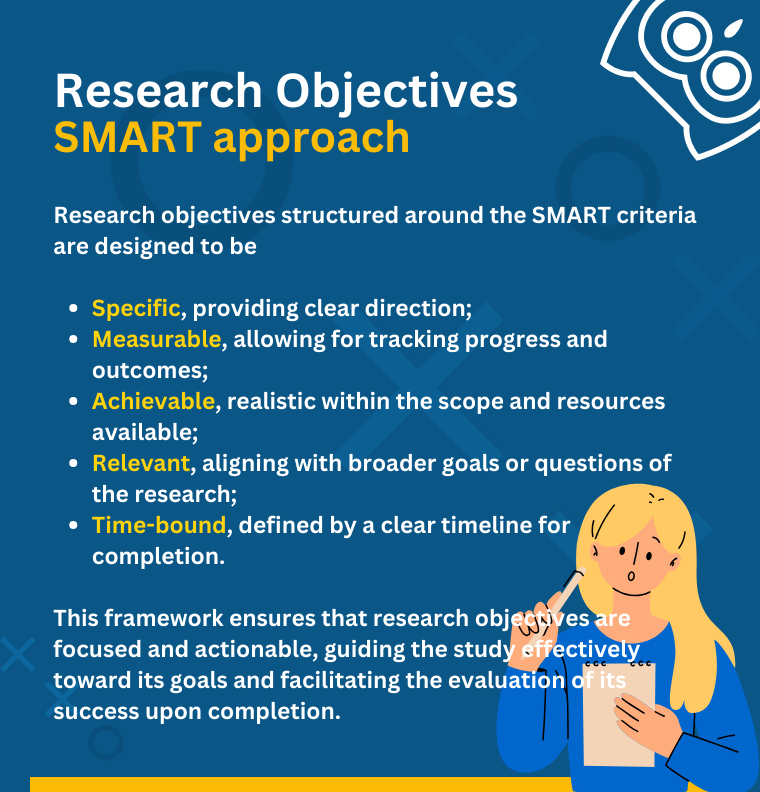
The effective objective of research is pivotal in laying the groundwork for a successful investigation. These objectives clarify the focus of your study and determine its direction and scope. Ensuring that your objectives are well-defined and aligned with the SMART criteria is crucial for setting a strong foundation for your research.
Key characteristics of well-defined research objectives
Well-defined research objectives are characterized by the SMART criteria – Specific, Measurable, Achievable, Relevant, and Time-bound. Specific objectives clearly define what you plan to achieve, eliminating any ambiguity. Measurable objectives allow you to track progress and assess the outcome. Achievable objectives are realistic, considering the research sources and time available. Relevant objectives align with the broader goals of your field or research question. Finally, Time-bound objectives have a clear timeline for completion, adding urgency and a schedule to your work.
Step-by-Step Guide on How to Formulate Both General and Specific Research Objectives
So lets get to the part, how to write research objectives properly?
- Understand the issue or gap in existing knowledge your study aims to address.
- Gain insights into how similar challenges have been approached to refine your objectives.
- Articulate the broad goal of research based on your understanding of the problem.
- Detail the specific aspects of your research, ensuring they are actionable and measurable.
How to Know When Your Objectives Need Refinement
Your objectives of research may require refinement if they lack clarity, feasibility, or alignment with the research problem. If you find yourself struggling to design experiments or methods that directly address your objectives, or if the objectives seem too broad or not directly related to your research question, it’s likely time for refinement. Additionally, objectives in research proposal that do not facilitate a clear measurement of success indicate a need for a more precise definition. Refinement involves ensuring that each objective is specific, measurable, achievable, relevant, and time-bound, enhancing your research’s overall focus and impact.
Research Objectives Examples in Different Fields
The application of research objectives spans various academic disciplines, each with its unique focus and methodologies. To illustrate how the objectives of the study guide a research paper across different fields, here are some research objective examples:
- In Health Sciences , a research aim may be to “determine the efficacy of a new vaccine in reducing the incidence of a specific disease among a target population within one year.” This objective is specific (efficacy of a new vaccine), measurable (reduction in disease incidence), achievable (with the right study design and sample size), relevant (to public health), and time-bound (within one year).
- In Environmental Studies , the study objectives could be “to assess the impact of air pollution on urban biodiversity over a decade.” This reflects a commitment to understanding the long-term effects of human activities on urban ecosystems, emphasizing the need for sustainable urban planning.
- In Economics , an example objective of a study might be “to analyze the relationship between fiscal policies and unemployment rates in developing countries over the past twenty years.” This seeks to explore macroeconomic trends and inform policymaking, highlighting the role of economic research study in societal development.
These examples of research objectives describe the versatility and significance of research objectives in guiding scholarly inquiry across different domains. By setting clear, well-defined objectives, researchers can ensure their studies are focused and impactful and contribute valuable knowledge to their respective fields.
Defining research studies objectives and problem statement is not just a preliminary step, but a continuous guiding force throughout the research journey. These goals of research illuminate the path forward and ensure that every stride taken is meaningful and aligned with the ultimate goals of the inquiry. Whether through the meticulous application of the SMART criteria or the strategic alignment with research questions and hypotheses, the rigor in crafting and refining these objectives underscores the integrity and relevance of the research. As scholars venture into the vast terrains of knowledge, the clarity, and precision of their objectives serve as beacons of light, steering their explorations toward discoveries that advance academic discourse and resonate with the broader societal needs.
Readers also enjoyed

WHY WAIT? PLACE AN ORDER RIGHT NOW!
Just fill out the form, press the button, and have no worries!
We use cookies to give you the best experience possible. By continuing we’ll assume you board with our cookie policy.
Stay ahead of the AI revolution.

How to Write a Research Objective: A Step-by-Step Guide
Writing research objectives is a crucial step for any research project. Without clear and concise objectives, a researcher may wander aimlessly, making the task of achieving the research goal that much harder. In this guide, we will outline the steps required to write effective research objectives, as well as provide some tips to help ensure your objectives are strong.
Understanding Research Objectives
Research objectives are the specific goals that a researcher aims to achieve through their research study. These objectives are developed to guide the research process and provide a clear plan for how the research will be conducted, analyzed, and evaluated.
Definition of Research Objectives
Research objectives are statements that describe the specific outcomes that the researcher hopes to achieve through their study. These objectives should be specific, measurable, and achievable, ensuring that they can be evaluated at the end of the research process.
For instance, if a researcher is conducting a study on the impact of social media on mental health, the research objectives could be:
- To identify the most popular social media platforms used by individuals with mental health issues.
- To determine the frequency and duration of social media use among individuals with mental health issues.
- To assess the relationship between social media use and mental health symptoms such as anxiety and depression.
- To explore the potential benefits and drawbacks of social media use for individuals with mental health issues.
Importance of Clear Research Objectives
Clear research objectives are essential to a successful research project. Without clear objectives, researchers may struggle to determine what they are trying to achieve, making it challenging to evaluate the success of the study. Clear objectives ensure that researchers stay focused and on track throughout the research process, resulting in a more successful study.
Furthermore, clear research objectives help to ensure that the study is relevant and meaningful. By clearly defining the objectives, researchers can ensure that the study addresses a specific research question or gap in the existing literature. This can help to increase the impact of the research and provide valuable insights into the topic being studied.
In addition, clear research objectives can also help to increase the credibility of the research. By clearly stating the objectives, researchers can demonstrate that they have a clear plan for how the research will be conducted and evaluated. This can help to increase the confidence of readers in the findings of the study.
Types of Research Objectives
Research objectives are an essential element of any research study. They outline what the researcher hopes to achieve by conducting the study and provide a clear direction for the research process. There are four main types of research objectives, each with its own unique purpose and focus.
Descriptive Objectives
Descriptive objectives aim to provide a detailed description of something in the research study. These objectives generally involve describing specific characteristics or properties of a subject. For example, a descriptive objective might be to describe the demographics of a particular population or to document the prevalence of a specific health condition.
Descriptive objectives are often used in exploratory research, where the goal is to gain a better understanding of a particular phenomenon or to generate hypotheses for further research. By providing a detailed description of the subject, researchers can identify patterns, trends, and relationships that may not have been apparent otherwise.
Analytical Objectives
Analytical objectives aim to analyze the relationship between different variables in a study. These objectives generally involve determining the cause-and-effect relationship between two or more variables. For example, an analytical objective might be to determine the relationship between a person's level of physical activity and their risk of developing heart disease.
Analytical objectives are often used in experimental research, where the goal is to test a specific hypothesis. By analyzing the relationship between variables, researchers can identify the factors that contribute to a particular outcome and determine the most effective interventions or treatments.
Predictive Objectives
Predictive objectives aim to predict what might happen in the future. These objectives generally involve determining the likelihood of a particular outcome based on certain factors. For example, a predictive objective might be to predict the likelihood of a student dropping out of school based on their academic performance and socio-economic background.
Predictive objectives are often used in forecasting research, where the goal is to anticipate future trends or events. By predicting the likelihood of a particular outcome, researchers can develop strategies to prevent or mitigate negative outcomes.
Evaluative Objectives
Evaluative objectives aim to evaluate whether something is effective or not. These objectives generally involve determining the effectiveness of a program, intervention, or treatment method. For example, an evaluative objective might be to evaluate the effectiveness of a new medication in treating a particular health condition.
Evaluative objectives are often used in applied research, where the goal is to improve a particular process or outcome. By evaluating the effectiveness of a program or intervention, researchers can identify areas for improvement and develop strategies to optimize outcomes.
Overall, understanding the different types of research objectives is essential for choosing the right type for your research study. By selecting the appropriate research objectives, you can ensure that your study is focused, relevant, and effective in achieving its goals.
Steps to Write Effective Research Objectives
Step 1: identify your research problem.
The first step in writing effective research objectives is to identify your research problem. What specific topic or area do you want to research? For example, if your research problem is examining the effects of childhood obesity on long-term health outcomes, your research objectives should be related to this topic.
Step 2: Review Relevant Literature
Reviewing relevant literature is an essential step in writing effective research objectives. This step will help you understand what has already been studied in the area of your research topic and identify any research gaps that you can focus on in your study. This information can then be used to develop your research objectives.
Step 3: Define Your Research Scope
Defining your research scope involves identifying the specific focus of your study. This step will help you narrow down your research objectives and make them more specific and achievable. For example, if your research topic is childhood obesity, your research scope could be the effects of a particular dietary intervention on the reduction of childhood obesity.
Step 4: Formulate Specific, Measurable Objectives
Formulating specific, measurable objectives is the most critical step in writing effective research objectives. Your objectives should be specific and clearly describe what you want to achieve in your study. They should also be measurable and include a clear method for evaluating whether the objective has been achieved.
Step 5: Refine and Finalize Your Objectives
After formulating your objectives, it is important to refine and finalize them. This involves reviewing your objectives and ensuring they align with your research question, checking to see that they are realistic, and feasible, and making any necessary adjustments.
Tips for Writing Strong Research Objectives
Be concise and clear.
Your research objectives should be concise and clear. They should not be ambiguous or open to interpretation, as this can lead to confusion throughout the research process.
Align with Your Research Questions
Your research objectives should align with your research questions. This ensures that your study remains focused and that all objectives are related to achieving your primary research question.
Ensure Feasibility
When writing research objectives, it is important to ensure that they are achievable and realistic. This will help prevent frustration and ensure that your study can be completed within the allocated time and resources.
Use Action Verbs
Finally, when writing research objectives, use action verbs to describe what you want to achieve. This will help make your objectives more specific and measurable, providing a clear plan for how the research will be conducted.
In conclusion, writing effective research objectives requires careful planning and attention to detail. By following the steps outlined in this guide and using the tips provided, researchers can ensure that their objectives are clear, concise, and achievable, resulting in a more successful research study.
ChatGPT Prompt for Writing a Research Objective
Chatgpt prompt.
Please articulate a clear and specific statement that outlines the purpose and scope of your research project. This should include a concise description of the problem or question you are seeking to address, the methods and data sources you will use to investigate it, and the intended outcomes or contributions of your study. Your research objective should be focused, measurable, and achievable within the constraints of your resources and timeline.
[ADD ADDITIONAL CONTEXT. CAN USE BULLET POINTS.]
Recommended Articles
How to write a theme: a step-by-step guide, how to write a research title: a step-by-step guide, feeling behind on ai, get the latest ai.

Get Your Free ChatGPT Training!

ChatGPT: Zero to Power User Cheat Sheet
- Top AI tools to use at work.
- Prompt frameworks.
- What NOT to use ChatGPT for.
.jpg)
Free AI Course for Professionals

Why 400,000+ Professionals Use The Neuron to Have An Edge Over Peers At Work
.jpg)

Research Objectives | Examples & How To Write Them

Introduction
Why are research objectives important, characteristics of research objectives, what is an example of a research objective, types of research objectives, formulating research objectives.
Research objectives are clear, concise statements that outline what a research project aims to achieve. They guide the direction of the study, ensuring that researchers stay focused and organized. Properly formulated objectives help in identifying the scope of the research and the methods to be used. This article will cover the importance of research objectives, their characteristics, examples, types, and how to write them. By understanding these elements, researchers can develop effective research aims that enhance the clarity and purpose of their studies. This straightforward approach will provide practical guidance for both novice and experienced researchers in crafting clear research objectives.

Research objectives provide a clear focus and direction for a study. A well-defined research aim can help researchers stay on track by outlining specific goals that need to be achieved. This clarity ensures that all aspects of the research are aligned with the intended outcomes.
Having well-defined objectives also facilitates effective planning and execution. Researchers can allocate resources more efficiently, select appropriate methodologies , and set realistic timelines. Moreover, clear objectives help in the assessment and evaluation of the research process and its outcomes, making it easier to determine whether the study has been successful.
Research objectives also enhance communication. They allow researchers to clearly convey the purpose and scope of their study to stakeholders, including funding bodies, academic peers, and participants. This transparency builds credibility and trust, which are essential for the integrity of the research process.
Research objectives possess several key characteristics that make them effective and useful for guiding a study. These characteristics ensure that the objectives are clear, achievable, and relevant to the research problem . Here are the essential characteristics to keep in mind when you develop research objectives for a successful research project.
- Specific : Research objectives focus on what the researcher intends to accomplish in a precise and unambiguous manner. Specific objectives break a research study into discrete and manageable tasks.
- Measurable : Objectives should include criteria for measuring progress and success. This characteristic allows researchers to track their progress and determine whether the objectives have been achieved.
- Achievable : Objectives need to be realistic and attainable within the constraints of the research project, including time, resources, and expertise. Setting achievable goals prevents frustration and ensures steady progress.
- Relevant : Objectives must be aligned with the research problem and the overall purpose of the study. They should contribute directly to addressing the study's research question or research hypothesis.
- Time-bound : Objectives should have a clear timeline for completion. This characteristic helps in planning and managing the research process, ensuring that objectives are met within a specified period.
- Clear and concise : Objectives should be articulated in a straightforward manner, avoiding complex language and jargon. Clarity helps in communicating the objectives to others involved in the research process.
- Focused : Each objective should target a specific aspect of the research problem. Having focused objectives prevents the study from becoming too broad and unmanageable.
- Logical : Objectives should follow a logical sequence that reflects the research process. This characteristic ensures that the objectives build on one another and collectively contribute to the overall research aim.
- Feasible : Consider the availability of resources, including data, equipment, and personnel, when formulating objectives. Feasibility ensures that the objectives can be realistically achieved with the available resources.
- Ethical : Objectives should respect ethical standards and guidelines . They should consider the well-being of participants, confidentiality , and integrity of the research process.
By adhering to these characteristics, researchers can develop objectives that are effective in guiding their study. Clear and well-defined objectives not only enhance the research process but also improve the quality and credibility of the research outcomes.

Scientific knowledge is easy to generate with ATLAS.ti
From collecting data to generating insights, do it all with ATLAS.ti. Get started with a free trial.
To illustrate what a well-defined research objective might look like, consider a study focused on improving reading comprehension among elementary school students. The research aims to evaluate the effectiveness of a new instructional strategy designed to enhance students' reading skills. Here is an example of a research objective for this study:
"To assess the impact of the interactive reading program on the reading comprehension scores of third-grade students over a six-month period."
This objective is effective because it meets several key criteria:
- Specific : The objective clearly states what will be assessed (the impact of the interactive reading program) and the target group (third-grade students).
- Measurable : The impact will be measured by changes in reading comprehension scores, providing a clear metric for evaluation.
- Achievable : The objective is realistic and attainable within a six-month period, assuming the necessary resources and support are available.
- Relevant : The objective is directly related to the study's research questions , which is to improve reading comprehension among elementary school students.
- Time-bound : The objective specifies a six-month period for the assessment, ensuring that the study is conducted within a defined timeframe.
By formulating objectives in this manner, researchers can create a clear roadmap for their study from research design to research paper . This example demonstrates how to incorporate the essential characteristics of research objectives into a practical and actionable statement.
Well-defined objectives help in planning the study, selecting an appropriate research methodology , and evaluating the outcomes. They also facilitate effective communication among members of the research team and with stakeholders, ensuring that everyone involved understands the purpose and scope of the research.
Research objectives can be categorized into different types based on their purpose and focus. Understanding these types helps researchers design studies that effectively address their research questions . Here are three common types of research objectives:
Descriptive objectives
Descriptive objectives aim to describe the characteristics or functions of a particular phenomenon or group. These objectives are often used in exploratory studies to gather information and provide a detailed picture of the subject being investigated. For example, a descriptive objective might be, "To describe the dietary habits of teenagers in urban areas." This type of objective helps in understanding the current state or conditions of the research subject.
Exploratory objectives
Exploratory objectives seek to explore new areas of knowledge or investigate relationships between variables. These objectives are often used in the initial stages of research to identify patterns, generate propositions, or uncover insights that can lead to further studies. An example of an exploratory objective is, "To investigate the relationship between social media usage and academic performance among college students." This type of objective is useful for studies that aim to look into new or under-researched areas.
Explanatory objectives
Explanatory objectives aim to explain the causes or reasons behind a particular phenomenon. These objectives often involve verifying a theory or determining relationships among variables. For instance, an explanatory objective could be, "To determine the impact of a structured exercise program on the mental health of elderly individuals." This type of objective is essential for studies that seek to understand the underlying mechanisms or effects of specific interventions or conditions.
Writing research aims is a critical step in the research process . Well-defined objectives provide a roadmap for the study and help ensure that the research stays focused and relevant. Here are some steps to guide the formulation of research objectives:
- Identify the research problem : Start by clearly defining the research problem or question you aim to address. Understanding the core issue helps in developing objectives that are directly related to the research focus.
- Conduct a literature review : Review existing research related to your topic to identify gaps in knowledge and areas that need further investigation. This background information can help in shaping specific and relevant objectives.
- Define the scope : Determine the scope of your study by considering factors such as the population, setting, and time frame. This will help in setting realistic and achievable objectives.
- Use the SMART criteria : Ensure that your objectives are Specific, Measurable, Achievable, Relevant, and Time-bound. This framework helps in creating clear and focused objectives that can guide the research process effectively.
- Break down the main objective : If your research has a broad aim, break it down into smaller, more specific sub-objectives. This makes the research more manageable and allows for a systematic approach to addressing the main research problem.
- Phrase objectives clearly : Write your objectives in clear and concise language, avoiding jargon and complex terms. Each objective should be easy to understand and communicate to others involved in the research.
- Align with research questions : Ensure that each objective aligns with your research question(s). The objectives should directly contribute to answering the key questions posed by your study.
- Seek feedback : Discuss your research objectives with peers, advisors, or experts in the field. Feedback can help refine the objectives and ensure that they are realistic and relevant.
Turn to ATLAS.ti for your research studies
Powerful data analysis with an intuitive interface is just a few clicks away. Download a free trial.


Handy Tips To Write A Clear Research Objectives With Examples
Introduction.
Research objectives play a crucial role in any research study. They provide a clear direction and purpose for the research, guiding the researcher in their investigation. Understanding research objectives is essential for conducting a successful study and achieving meaningful results.
In this comprehensive review, we will delve into the definition of research objectives, exploring their characteristics, types, and examples. We will also discuss the relationship between research objectives and research questions , as well as provide insights into how to write effective research objectives. Additionally, we will examine the role of research objectives in research methodology and highlight the importance of them in a study. By the end of this review, you will have a comprehensive understanding of research objectives and their significance in the research process.
Definition of Research Objectives: What Are They?

A research objective is defined as a clear and concise statement that outlines the specific goals and aims of a research study. These objectives are designed to be specific, measurable, achievable, relevant, and time-bound (SMART), ensuring they provide a structured pathway to accomplishing the intended outcomes of the project. Each objective serves as a foundational element that summarizes the purpose of your study, guiding the research activities and helping to measure progress toward the study’s goals. Additionally, research objectives are integral components of the research framework , establishing a clear direction that aligns with the overall research questions and hypotheses. This alignment helps to ensure that the study remains focused and relevant, facilitating the systematic collection, analysis, and interpretation of data.
Characteristics of Effective Research Objectives
Characteristics of research objectives include:
- Specific: Research objectives should be clear about the what, why, when, and how of the study.
- Measurable: Research objectives should identify the main variables of the study that can be measured or observed.
- Relevant: Research objectives should be relevant to the research topic and contribute to the overall understanding of the subject.
- Feasible: Research objectives should be achievable within the constraints of time, resources, and expertise available.
- Logical: Research objectives should follow a logical sequence and build upon each other to achieve the overall research goal.
- Observable: Research objectives should be observable or measurable in order to assess the progress and success of the research project.
- Unambiguous: Research objectives should be clear and unambiguous, leaving no room for interpretation or confusion.
- Measurable: Research objectives should be measurable, allowing for the collection of data and analysis of results.
By incorporating these characteristics into research objectives, researchers can ensure that their study is focused, achievable, and contributes to the body of knowledge in their field.
Types of Research Objectives
Research objective can be broadly classified into general and specific objectives. General objectives are broad statements that define the overall purpose of the research. They provide a broad direction for the study and help in setting the context. Specific objectives, on the other hand, are detailed objectives that describe what will be researched during the study. They are more focused and provide specific outcomes that the researcher aims to achieve. Specific objectives are derived from the general objectives and help in breaking down the research into smaller, manageable parts. The specific objectives should be clear, measurable, and achievable. They should be designed in a way that allows the researcher to answer the research questions and address the research problem.
In addition to general and specific objectives, research objective can also be categorized as descriptive or analytical objectives. Descriptive objectives focus on describing the characteristics or phenomena of a particular subject or population. They involve surveys, observations, and data collection to provide a detailed understanding of the subject. Analytical objectives, on the other hand, aim to analyze the relationships between variables or factors. They involve data analysis and interpretation to gain insights and draw conclusions.
Both descriptive and analytical objectives are important in research as they serve different purposes and contribute to a comprehensive understanding of the research topic.
Examples of Research Objectives
Here are some examples of research objectives in different fields:
1. Objective: To identify key characteristics and styles of Renaissance art.
This objective focuses on exploring the characteristics and styles of art during the Renaissance period. The research may involve analyzing various artworks, studying historical documents, and interviewing experts in the field.
2. Objective: To analyze modern art trends and their impact on society.
This objective aims to examine the current trends in modern art and understand how they influence society. The research may involve analyzing artworks, conducting surveys or interviews with artists and art enthusiasts, and studying the social and cultural implications of modern art.
3. Objective: To investigate the effects of exercise on mental health.
This objective focuses on studying the relationship between exercise and mental health. The research may involve conducting experiments or surveys to assess the impact of exercise on factors such as stress, anxiety, and depression.
4. Objective: To explore the factors influencing consumer purchasing decisions in the fashion industry.
This objective aims to understand the various factors that influence consumers’ purchasing decisions in the fashion industry. The research may involve conducting surveys, analyzing consumer behavior data, and studying the impact of marketing strategies on consumer choices.
5. Objective: To examine the effectiveness of a new drug in treating a specific medical condition.
This objective focuses on evaluating the effectiveness of a newly developed drug in treating a particular medical condition. The research may involve conducting clinical trials, analyzing patient data, and comparing the outcomes of the new drug with existing treatment options.
These examples demonstrate the diversity of research objectives across different disciplines. Each objective is specific, measurable, and achievable, providing a clear direction for the research study.
Aligning Research Objectives with Research Questions
Research objectives and research questions are essential components of a research project. Research objective describe what you intend your research project to accomplish. They summarize the approach and purpose of the project and provide a clear direction for the research. Research questions, on the other hand, are the starting point of any good research. They guide the overall direction of the research and help identify and focus on the research gaps .
The main difference between research questions and objectives is their form. Research questions are stated in a question form, while objectives are specific, measurable, and achievable goals that you aim to accomplish within a specified timeframe. Research questions are broad statements that provide a roadmap for the research, while objectives break down the research aim into smaller, actionable steps.
Research objectives and research questions work together to form the ‘golden thread’ of a research project. The research aim specifies what the study will answer, while the objectives and questions specify how the study will answer it. They provide a clear focus and scope for the research project, helping researchers stay on track and ensure that their study is meaningful and relevant.
When writing research objectives and questions, it is important to be clear, concise, and specific. Each objective or question should address a specific aspect of the research and contribute to the overall goal of the study. They should also be measurable, meaning that their achievement can be assessed and evaluated. Additionally, research objectives and questions should be achievable within the given timeframe and resources of the research project. By clearly defining the objectives and questions, researchers can effectively plan and execute their research, leading to valuable insights and contributions to the field.
Guidelines for Writing Clear Research Objectives
Writing research objective is a crucial step in any research project. The objectives provide a clear direction and purpose for the study, guiding the researcher in their data collection and analysis. Here are some tips on how to write effective research objective:
1. Be clear and specific
Research objective should be written in a clear and specific manner. Avoid vague or ambiguous language that can lead to confusion. Clearly state what you intend to achieve through your research.
2. Use action verbs
Start your research objective with action verbs that describe the desired outcome. Action verbs such as ‘investigate’, ‘analyze’, ‘compare’, ‘evaluate’, or ‘identify’ help to convey the purpose of the study.
3. Align with research questions or hypotheses
Ensure that your research objectives are aligned with your research questions or hypotheses. The objectives should address the main goals of your study and provide a framework for answering your research questions or testing your hypotheses.
4. Be realistic and achievable
Set research objectives that are realistic and achievable within the scope of your study. Consider the available resources, time constraints, and feasibility of your objectives. Unrealistic objectives can lead to frustration and hinder the progress of your research.
5. Consider the significance and relevance
Reflect on the significance and relevance of your research objectives. How will achieving these objectives contribute to the existing knowledge or address a gap in the literature? Ensure that your objectives have a clear purpose and value.
6. Seek feedback
It is beneficial to seek feedback on your research objectives from colleagues, mentors, or experts in your field. They can provide valuable insights and suggestions for improving the clarity and effectiveness of your objectives.
7. Revise and refine
Research objectives are not set in stone. As you progress in your research, you may need to revise and refine your objectives to align with new findings or changes in the research context. Regularly review and update your objectives to ensure they remain relevant and focused.
By following these tips, you can write research objectives that are clear, focused, and aligned with your research goals. Well-defined objectives will guide your research process and help you achieve meaningful outcomes.
The Role of Research Objectives in Research Methodology
Research objectives play a crucial role in the research methodology . In research methodology, research objectives are formulated based on the research questions or problem statement. These objectives help in defining the scope and focus of the study, ensuring that the research is conducted in a systematic and organized manner.
The research objectives in research methodology act as a roadmap for the research project. They help in identifying the key variables to be studied, determining the research design and methodology, and selecting the appropriate data collection methods .
Furthermore, research objectives in research methodology assist in evaluating the success of the study. By setting clear objectives, researchers can assess whether the desired outcomes have been achieved and determine the effectiveness of the research methods employed. It is important to note that research objectives in research methodology should be aligned with the overall research aim. They should address the specific aspects or components of the research aim and provide a framework for achieving the desired outcomes.
Understanding The Dynamic of Research Objectives in Your Study
The research objectives of a study play a crucial role in guiding the research process, ensuring that the study is focused, purposeful, and contributes to the advancement of knowledge in the field. It is important to note that the research objectives may evolve or change as the study progresses. As new information is gathered and analyzed, the researcher may need to revise the objectives to ensure that they remain relevant and achievable.
In summary, research objectives are essential components in writing an effective research paper . They provide a roadmap for the research process, guiding the researcher in their investigation and helping to ensure that the study is purposeful and meaningful. By understanding and effectively utilizing research objectives, researchers can enhance the quality and impact of their research endeavors.
Leave a Comment Cancel reply
Save my name, email, and website in this browser for the next time I comment.
Related articles

Logistic Regression: 8 Comprehensive Guide to Data Study

Decision Trees: 8 Best Insights for Smarter Data Analysis

5 Essential Insights Into Linear Regression Applications

6 Breakthrough Insights of Reinforcement Learning Algorithms

7 Breakthrough Insights of Unsupervised Learning Algorithms

8 Best Insights of Supervised Learning Algorithms Unveiled

Defining Your Research Interest: 4 Essential Tips!

Significance of Quantitative Research : 9 Essential Insights

IMAGES
COMMENTS
Mar 25, 2024 · Tips for Writing Strong Research Objectives. Focus on the Research Problem: Ensure each objective directly addresses the central research question. Keep Objectives Measurable: Use specific, quantifiable terms to track progress and outcomes. Limit the Number of Objectives: Avoid overloading your study with too many goals. Aim for 3–5 specific ...
Jul 12, 2022 · Contribute to your research design: When you know what your objectives are, you have a clearer idea of what methods are most appropriate for your research. Indicate how your project will contribute to extant research: They allow you to display your knowledge of up-to-date research, employ or build on current research methods, and attempt to ...
Sep 5, 2023 · The research aim provides the study with direction, while the research objectives set the path to achieving this aim, thereby ensuring the study’s efficiency and effectiveness. How to Write Research Objectives. I usually recommend to my students that they use the SMART framework to create their research objectives.
Jul 14, 2023 · Research objectives can be broadly classified into general and specific objectives. 4 General objectives state what the research expects to achieve overall while specific objectives break this down into smaller, logically connected parts, each of which addresses various parts of the research problem. General objectives are the main goals of the ...
Sep 8, 2023 · Time-bound: Research objectives may have associated timelines or deadlines to indicate when the research aims should be accomplished. Research objectives help researchers stay focused on the purpose of their study and guide the development of research methods, data collection, and analysis. They also serve as a basis for evaluating the success ...
Oct 23, 2024 · Types of research objectives . Research objective at an overall level can be divided into . General objectives: the broad goals of your study ; Specific objectives: Precise, measurable outcomes that you hope to achieve ; Let’s take an example:
Mar 27, 2024 · Research Objectives Examples in Different Fields. The application of research objectives spans various academic disciplines, each with its unique focus and methodologies. To illustrate how the objectives of the study guide a research paper across different fields, here are some research objective examples:
Types of Research Objectives. Research objectives are an essential element of any research study. They outline what the researcher hopes to achieve by conducting the study and provide a clear direction for the research process. There are four main types of research objectives, each with its own unique purpose and focus. Descriptive Objectives
Characteristics of research objectives. Research objectives possess several key characteristics that make them effective and useful for guiding a study. These characteristics ensure that the objectives are clear, achievable, and relevant to the research problem. Here are the essential characteristics to keep in mind when you develop research ...
Nov 3, 2024 · A research objective is defined as a clear and concise statement that outlines the specific goals and aims of a research study. These objectives are designed to be specific, measurable, achievable, relevant, and time-bound (SMART), ensuring they provide a structured pathway to accomplishing the intended outcomes of the project.